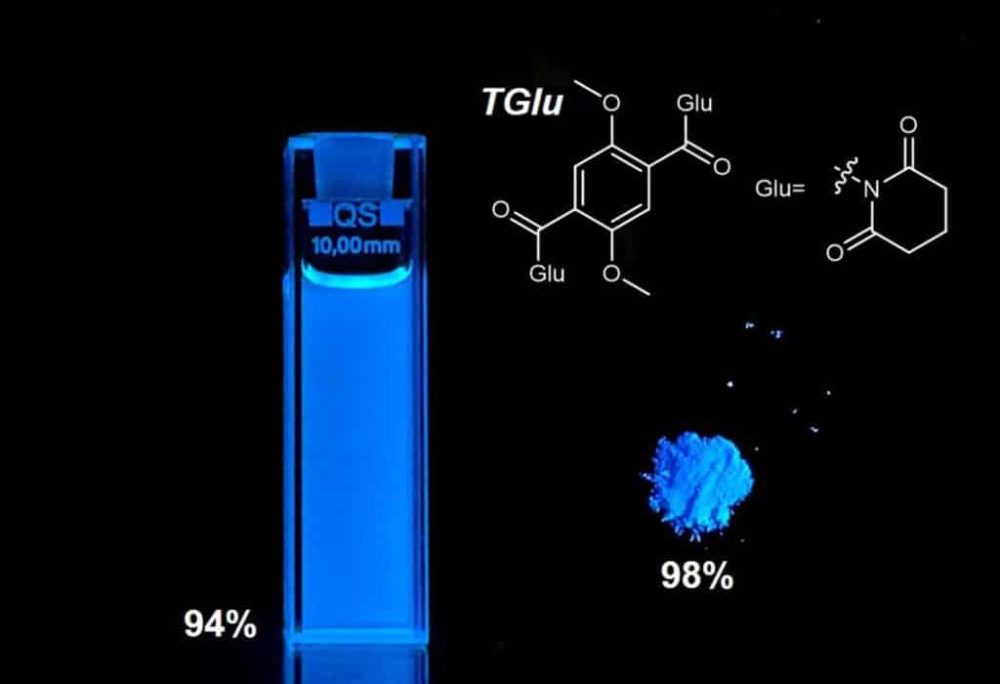A record-breaking fluorescent molecule developed by University of Michigan researchers shines brighter than ever, offering up to 98% efficiency in solids and 94% in liquids. And it could be the key to better displays, sensors, and even medical diagnostics.
Imagine your phone screen, smart sensor, or medical imaging tool glowing brighter, more efficiently, and at a lower production cost. That’s the promise of a tiny blue molecule scientists just unveiled—one that could soon replace the fluorescent materials used in everything from OLED TVs to bioimaging tools.
Developed by researchers at the University of Michigan and dubbed TGlu, this molecule is being called a breakthrough in light-emitting materials. In tests, it delivered a stunning 98% quantum efficiency in solid form and 94% in liquid form—shattering previous records and solving a problem that’s long held back the industry.
The Significance Of This Discovery
Fluorescent molecules, also known as fluorophores, emit light after absorbing energy. They’re the glow behind your OLED screen and the highlighter that makes cells visible under a microscope. However, most fluorophores perform well in either the solid state or in solution, but not both.
This new molecule does both with unprecedented efficiency. And that changes everything.
“We’ve reduced development time and cost for future applications by designing a fluorophore that performs beautifully across environments,” said Professor Jinsang Kim, who led the study published in Nature Communications.
An Accidental Breakthrough
The discovery wasn’t even the original goal. Postdoctoral researcher Jung-Moo Heo stumbled upon TGlu as a side product while designing another molecule. However, during purification, he noticed something unusual: it glowed brightly in both liquid and solid forms.
Instead of discarding it, the team leaned in, designing a molecule around that performance. The result is a deceptively simple structure: a single benzene ring with a unique pattern of electron-donating and electron-withdrawing groups arranged to stabilize energy transfer.
How TGlu Works: A Quick Science Snapshot
- Stable and symmetric: The molecule’s “quadrupolar” design evenly distributes electrical charges, making it emit light reliably in different conditions.
- Energy-efficient jump: It needs less energy to get excited, yet still releases high-energy blue light, rare for a small molecule.
- No energy leaks: Unlike most blue-emitting fluorophores, TGlu avoids heat loss thanks to a unique acceptor group that blocks the “escape hatches” for energy, a phenomenon known as the Inverted Energy Gap Law.
- No brightness loss: In solid form, bulky chemical arms prevent molecules from clumping and “quenching” each other’s light.
What Does This Mean For The Real World
Because it works across both solids and solutions, TGlu could streamline the production of advanced materials for:
- OLED screens and flexible electronics
- Bioimaging and real-time disease detection
- Wearable health sensors
- Chemical detection in environmental monitoring
And since it can be synthesized in just three steps, it’s far more scalable than traditional complex fluorescent compounds, slashing manufacturing costs.
“This is nature meets simplicity,” said Heo. “It’s small, stable, cheap, and powerful.”
What’s next?
The current version of TGlu emits blue light. However, researchers are already working on modifying the molecule to alter its color by adjusting the energy band gap. They’re also exploring electrical excitation, which is crucial for the real-world performance of devices like TVs and smartphones.
They’re also eyeing a shift to phosphorescent versions, which are even more energy-efficient and commonly used in OLEDs, promising another leap in display tech.
In A Nutshell
This tiny molecule—discovered almost by accident—has the potential to change how we design and manufacture glowing materials across industries. With record-setting performance, low cost, and versatility, TGlu is a bright new star in the world of advanced materials.
If the fluorescent molecules of today are lightbulbs, TGlu is a laser pointer—precise, efficient, and ready to lead the way.


